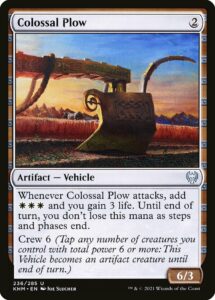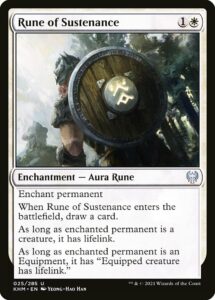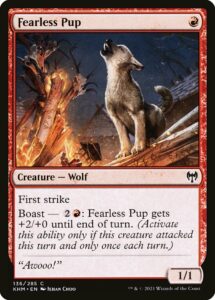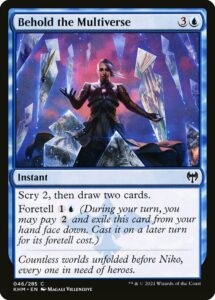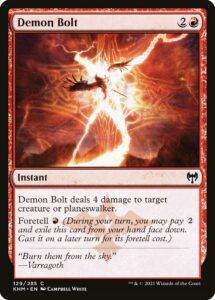Next week, Kamigawa: Neon Dynasty releases, bringing with it a slew of mechanics, both new and returning, named and unnamed. But as wait for preview season to finish and prerelease to begin, let’s take a moment to look backwards at how far we’ve come.
Last year might have been disastrous in many ways, but Magic’s new mechanics offered plenty of exciting design lessons. So, please join me as we finish our five part series reviewing all the new Standard mechanics of 2021. We’ve done Innistrad: Crimson Vow, Innistrad: Midnight Hunt, Adventures in the Forgotten Realms, and Strixhaven. Now it’s time to go back a full year to the very first set of 2021: Kaldheim.
Many mechanics, yet few named mechanics
Kaldheim is a fascinating set. It brought back snow, changeling, and gods. It continued 2020-2021’s focus on modal double-faced cards. It focused lightly on tribal strategies, vehicles, equipment, and sagas. It introduced an unnamed mini-mechanic in white-black where you’re rewarded for casting your second spell (reminiscent of Oath of the Gatewatch’s Surge). That’s a lot going on, and we haven’t even touched on the set’s three new named mechanics: Foretell, Boast, and Runes.
I have mixed feelings about Kaldheim’s Limited format and set construction. I had a ton of fun drafting greedy snow decks, but felt that most of the format’s depth was concentrated in those few decks. The sheer volume of lightly-supported mechanics made it hard for any of them to function. The set all but deceived players by suggesting that archetypes like white-blue Foretell, black-red Boast, or black-green Elves had enough support to function. This was exacerbated by changeling (the cross-tribal glue) being exclusive to blue and green and snow (the most supported mechanic) being primary in those same colors.
I can’t help but feel that some of these issues stem from the set’s high volume of mechanics—it’s hard to enable everything when there is so much in need of enabling. I’ve already discussed my qualms with sets having too many mechanics and my amazement at how great design can turn that into a cohesive whole. Reflecting on all of 2021’s sets and looking ahead to Kamigawa, it appears that modern Magic will continue to feature a high density of mechanics. We’ll see how that goes and whether that even is a problem.
You’ve runed a couple of things
Runes are a new aura subtype, designed to go on creatures and equipment, as well as things that can become creatures like vehicles and creature lands. There are the barest minimum number of Rune cards to justify the mechanic’s existence: five Runes (one in each color) and two cards that care about them (Runeforge Champion and Runed Crown).
You can tell that every Rune is fairly weak when they all say, “draw a card.” Moreover, they don’t cost more than two mana—tacking “draw a card” onto anything tends to add two mana, so each Rune is worth less than one mana by itself. The fact that the two Rune support cards are a Demonic Tutor and a Tinker respectively tell you just how concerned Play Design was about Runes. Now, a mechanic being weak doesn’t make it bad, and there’s a lot more you can do with Runes than make new versions of Amonkhet’s Cartouches (but with less support). In fact, Kamigawa: Neon Dynasty has a clear followup to Runes with its auras that work on both creatures and vehicles.
Still, I’m not convinced that Runes had enough impact to justify their minimal inclusion in Kaldheim. I love having a reference to runes in Magic’s Norse mythology plane, but I wish there more of a design innovation than “creature auras that can also go on equipment.” That play pattern simply doesn’t work well given all the challenges equipment already face. I’d wager you could have accomplished the runic reference and design concept using one or two cards, without adding a new card type.
Runes feel like they were included for the sake of including them not because the set needed them. That’s a criticism I’ve also applied to Crimson Vow’s Cleave, so perhaps slightly extraneous mechanics are something we may become more accustomed to with time.
“Awooo!”
Many sets have workhorse mechanics. They’re not the splashiest and they’re not always the most supported, but they’re present in a decent volume and serve as an essential piece of structure. Kaldheim has a high density of quality removal. Much of the set’s power is focused in grindy snow decks. These factors create a need for an aggressive mechanic to punish players for being too greedy. After all, it’d be especially unfortunate if the set partially inspired by Viking raiders mostly eschewed combat.
Boast is a very knobby mechanic, meaning there are multiple knobs Play Design can adjust to make each card sing. Because Boast is an ability word, it doesn’t have to be consistent the way that keyword mechanics like Mentor and Exploit must be. Boast can take variable inputs (in this case, the mana cost of the Boast ability) and generate a wide variety of outputs (the spell effect you get). It’s smartly templated so the effect doesn’t have to be relevant in combat, so it can also include effects best in your postcombat main phase (avoiding a major issue of Cypher). And while there is a danger in having every uncontested Boast creature be able to generate value over time, the limitation of once per turn and only after attacking makes it far less likely a single Boaster will take over the game.
Boast under-performed significantly. Part of this is due to Boast creatures being antisynergistic—sure, they all want to attack, but they compete with each other (and your cards in hand!) for your mana. It’s just harder for an aggressive creature to succeed when you not only need to untap and attack with it, but also sink additional mana. The longer the game goes on, the more you can Boast and the better the mechanic gets, but a long game will also see all your Boast creatures invalidated by a single Ravenous Lindwurm.
Not all mechanics are winners, but Boast didn’t really serve its purpose well enough. The best aggressive decks barely Boasted, instead using Goldvein Pick as a more reliable way to generate mana and value rather than convert mana into minor value. Boast kind of reminds me of Training, where both mechanics didn’t really serve their roles as combat mechanics well and both may suffer from inherent issues that impede their functionality.
Tale as old as Kaldheim
I love Morph. I wasn’t playing when Onslaught first introduced it, but Morph is much of what made Khans of Tarkir one of my favorite formats ever. There’s something so exciting in having an open secret in front of your opponent, so tense about not knowing what your opponent just put in front of them, and so cool about trying to tease out what the trap is before your opponent springs it on you. Foretell is a great twist on Morph. It succeeds at being both a mana-smoothing and mystery-building mechanic. It’s heavily supported, with 36 cards bearing the mechanic in Kaldheim and another three that reference it. It feels different than Morph, where it’s both better at smoothing mana by virtue of only costing 2 mana and worse by virtue of adding nothing to the board. It also adds a nice little time delay, where your opponent has a brief window between you putting the card face-down and your being able to cast it.
The biggest issue I have with Foretell is that there aren’t enough Foretell cards—an issue that’s really a barely-disguised compliment. I love the mechanic and wish I could play more with it. Alas, there simply isn’t room in any single set for more than ~40 cards built around a single keyword mechanic. Still, I wish we could’ve skipped the MDFCs in Strixhaven and had more Foretell cards instead.
Sure, it would be dangerous to have too many Foretell cards that go in the same kinds of decks (players should be able to sometimes guess what their opponent has, so the possibility space can’t be enormous). But when you’re playing a singleton format like Commander or Cube rather than Standard, there’s no big guessing game over someone’s first Foretold card and no ambiguity over their second (assuming they even find it).
It’s been interesting reviewing last year’s major releases. I remembered Kaldheim and Strixhaven’s Limited formats as being fairly similar (mostly green/blue value decks vs. white aggro), yet I loved all of Strixhaven’s mechanics and was more tepid on Kaldheim’s (excepting Foretell). Sets are using larger numbers of named mechanics and including more lightly-used workhorse mechanics, like Investigate in Innistrad: Midnight Hunt and Runes in Kaldheim. This is distinct from the high complexity, rare-only mechanics that could only show up on small numbers of cards, mechanics like Epic, Offering, and Hideaway. This may well be a reaction to 2020’s heavy use of unnamed mini-mechanics—it’s probably better to call out and unify your subthemes rather than obscure them.
These changes make sense for a Magic that is both more digital and more focused on eternal play. Magic Arena makes it easier for players to learn more mechanics at once, since the engine ensures the cards both work properly and present an icon, explanation, and animation to guide the player. A couple Investigate cards don’t make for a focused Standard deck, but they can slot into Commander and Modern just fine. And it’s probably better for Standard if there’s less emphasis on pushing single set mechanics—that’s how you get Set Monsters like Energy, Food, and Vehicles.
This makes me wonder about what changes 2022 will bring, as well as what we can infer about what we know now looking back at the designs of 2020 and 2019. But those are considerations for another time. Thank you for joining me into this journey into the designs of last year. Here’s looking forward to all the new ones to come.
Zachary Barash is a New York City-based game designer and the commissioner of Team Draft League. He designs for Kingdom Death: Monster, has a Game Design MFA from the NYU Game Center, and does freelance game design. When the stars align, he streams Magic (but the stars align way less often than he’d like).

